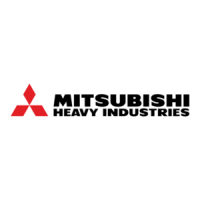
Do you have a question about the Mitsubishi Heavy Industries FDCW100VNX-A and is the answer not in the manual?
| Brand | Mitsubishi Heavy Industries |
|---|---|
| Model | FDCW100VNX-A |
| Category | Heat Pump |
| Language | English |
Essential safety instructions to follow before and during product use, including danger and caution warnings.
Safety guidelines for the proper installation of the unit to prevent hazards like electric shock or fire.
Safety measures to follow during the operation of the heat pump to avoid injury or malfunction.
Safety guidelines to be followed when moving or repairing the unit, emphasizing professional assistance.
Basic description of the Hydrolution system and its purpose for heating, cooling, and hot water.
Fields to be completed by the installation engineer for warranty and record-keeping purposes.
Key features and advantages of the Hydrolution heat pump system, such as inverter control and compact design.
Explanation of how the Hydrolution system functions to provide heating, hot water, and cooling.
Description of the symbols, buttons, and display elements on the indoor unit's front panel.
Instructions on navigating through menus, using buttons, and understanding panel functions like key lock and language.
How the heat pump operates to control heat production based on various temperature sensors and settings.
Explanation of different operating modes like Auto, AutoC, Heating, Cooling, Hot water, and Add. Heat only.
How to set and adjust the heating curve using menu 2.1.2 and the offset knob for optimal heating performance.
Procedures for readjusting heating curve and offset based on room temperature feedback for optimal comfort.
How to activate and configure cooling operation, including reliance on room and outdoor sensors.
Graphs showing available hot water volume at different stop temperatures for various models.
How the system prioritizes hot water production over heating/cooling when demand exists.
Details on activating and managing temporary, scheduled, and periodic extra hot water functions.
Information on the location and checks for safety valves within the indoor unit.
Steps for checking safety valves, pressure gauges, draining, and cleaning the outdoor unit.
Recommendations for optimizing energy consumption, including thermostat usage and insulation.
A guide to diagnosing and resolving common heating and hot water issues based on symptoms and causes.
Explanation of sounds that are normal during operation, not indicative of malfunctions.
Details on "Add. heat only" and Emergency mode operations and their activation.
Explanation of the front panel display, symbols, and how to navigate through menus and change parameters.
A hierarchical overview of all available control menus and sub-menus.
Descriptions of the main menu categories (1.0 to 8.0) and their general functions.
Detailed settings for hot water temperatures and supply temperatures for heating systems.
Settings for cooling operation, room temperature control, and circulation pump speed.
Settings for display, language, operation modes, current limiters, and phase currents.
Checklist items for verifying installation and function of hot water components.
Checklist items for verifying installation and function of heating, cooling systems, and refrigerant integrity.
Verification of electrical installation safety and installed accessories like circulation pumps and room sensors.
